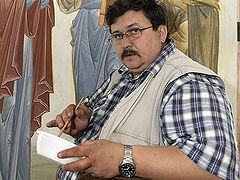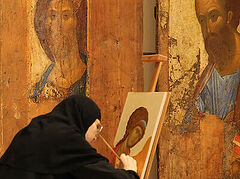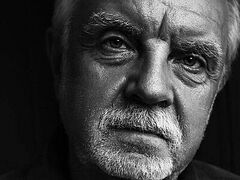“Now is the appropriate time to remember those who founded the School, who have inspired modern iconographers, and also to think about the future,” says Archimandrite Luke (Golovkov), the Dean of the Iconography Faculty, the Associate Professor of the Moscow Theological Academy.
Since 1991, Fr. Luke has been the Assistant Director of the Iconography School and its Director since 1993. As of September 2, 2019, he is the Dean of the Iconography Faculty of the Moscow Theological Academy.
—Father Luke, the 30th anniversary of the Trinity-Sergius Lavra’s Iconography School fell on a rather unusual year. For the first time in the School’s history, your graduates were unable to present their work. Has their graduation been delayed?
—Half a year ago, our students had to interrupt their studies and take an emergency recess. The icons, their thesis projects, were left unfinished. We have two projects ready for defense, but as we have to conform to the health safety regulations, we cannot hold the final thesis defense as yet.
—Do you conduct any distance learning classes?
—Theory lessons and iconography practicum can be held online, but it is impossible to study iconography online in any meaningful way.
 Archimandrite Luke (Golovkov) and the students of the Iconography Faculty of the Moscow Theological Academy. The (Gethsemane) Chernigovsky Skete. September 2019.
Archimandrite Luke (Golovkov) and the students of the Iconography Faculty of the Moscow Theological Academy. The (Gethsemane) Chernigovsky Skete. September 2019.
—Do your students do sketches of everyday life?
—I don’t think that secular art is useful for an iconographer. That doesn’t mean that they can’t take a break and paint a landscape or a portrait, but I don’t think you can be serious about church painting or a mosaic and interested in secular art at the same time. I can’t speak for a secular artist but it would negatively affect an iconographer. They have to concentrate on studying one or the other. Once you start painting an icon, you need to minimize any studies of secular art so that you can focus your attention on the icon. A basic skill set in sketching, painting and composition is a necessity though.
Only the artist involved in the life of the Church and who developed a prayerful relationship with God is able to paint icons
Icons and paintings have crucial differences. A painting reflects earthly life, its beauty and uniqueness, whereas an icon is of the heavenly world. Only the artist who is involved in the life of the Church and has developed a prayerful relationship with God can paint icons. The icon is a materialized prayer so it needs to become an informal, conscious, deeply felt prayer of the heart.
It is a great blessing for our iconography students that the School is located in the Lavra, a working monastery. It is extremely important that they study in the edifying atmosphere of a real Russian monastery. If an iconographer prays during his work, his creation will help others to acquire the true spirit of prayer. This is the meaning of the iconographer’s work, not in creating a canonically and artistically perfect image that is unable to penetrate deep inside people’s hearts.
 Hieromonk Nikodim (Sobolev), Panagia Glykophilousa. 2011. An iconographer must have a keen and intimate understanding of the image he is about to paint, or the icon will be empty and useless to help anyone praying before it. An iconographer working on a copy of miracle-working icons seeks God’s grace especially strongly. There were times when the whole monastery prayed about the successful painting of an icon’s copy. For example, when an Athonite iconographer was working on a copy of the wonder-working Iveron Icon of the Mother God to be sent to Russia, he took upon himself a special podvig of prayer and strict fasting while the rest of the monastery prayed for him.
Hieromonk Nikodim (Sobolev), Panagia Glykophilousa. 2011. An iconographer must have a keen and intimate understanding of the image he is about to paint, or the icon will be empty and useless to help anyone praying before it. An iconographer working on a copy of miracle-working icons seeks God’s grace especially strongly. There were times when the whole monastery prayed about the successful painting of an icon’s copy. For example, when an Athonite iconographer was working on a copy of the wonder-working Iveron Icon of the Mother God to be sent to Russia, he took upon himself a special podvig of prayer and strict fasting while the rest of the monastery prayed for him.
Certainly, when an iconographer is a believer, but not knowledgeable about his religion or a church-goer , we can only hope that somehow God will guide his hand. On the other hand, I have witnessed a few times when a successful secular artist, or a good sculptor, took on a church project and suddenly lost his professionalism.
—In order to paint an icon drawing us into prayer at a mere glance instead of being merely an example of religious art, do you need to be fully immersed in the life of the Church?
—Yes. Above all, you need to fully understand that our life here on earth is a fleeting moment. Since our human nature was distorted after the Fall, it is our task, while here on earth, to accept this fallen nature and realize that without God, without our Savior we cannot improve but will only fall. As long as the iconographer has such an understanding, he will will be praying in earnest. His theological knowledge is irrelevant. What is important is ceaseless repentance and devotion to God. This is what really matters.
 Шевцов Михаил. Преподобный Андрей Иконописец с житием. 2014 г. —Is this state you describe something anyone can reach by visiting church and reading spiritually enlightening literature, or is it something given only to the select few?
Шевцов Михаил. Преподобный Андрей Иконописец с житием. 2014 г. —Is this state you describe something anyone can reach by visiting church and reading spiritually enlightening literature, or is it something given only to the select few?
—One must be ready to work hard, and only those who push themselves to do hard work will be saved. Visiting a church can help someone acquire a temporary feeling of piety, but it is important that he labor in prayer outside of church if he wants to gain knowledge about himself. Being present at church can even be to our condemnation: A person can come to church but leave it devoid of spiritual gifts. Luckily, I think it doesn’t happen very often. Grace is a gift that is not bestowed without labor.
—An artist can be inspired and learn from different masters at different times, but is there any iconographer that is closest to your heart?
—I’m a bit of an ‘omnivore.’ Ancient icons are unsigned. There are some I like more and some I like less. Of course, I like Andrei Rublev and Theophanes the Greek. There are truly amazing icons from the fourteenth century, though they were painted by unknown masters. The iconographers prayed deeply and in earnest, and by the power of their prayer, they created these great pieces of work.
—Have you ever been through the artistic agony akin to that portrayed in the Tarkovsky’s film “Andrey Rublev?”
—You see, the agony shown in the film—whether he should paint “The Last Judgment”—seems strange for someone living the life of the Church. Any Orthodox believer should be ready to die and stand before the Judge every day. A reminder about the Day of Judgment shouldn’t be tragic or cause terror. It is a frontier that we may be frightening and painful to cross, but it isn’t a tragedy. We are conscious of our mortality, while remembrance of this is important for a Christian. Remembering this helps us sin less often. At times, we forget that our life is temporary and that we are citizens of heaven. The torments depicted in the movie you reference is most likely the personal experience of the movie’s creator instead of being anything experienced by St. Andrey Rublev.
 On May 1, 2019, Archimandrite Luke (Golovkov) presided at the Paschal Liturgy and the procession at the Church of the Holy Spirit in Lavra
On May 1, 2019, Archimandrite Luke (Golovkov) presided at the Paschal Liturgy and the procession at the Church of the Holy Spirit in Lavra
—How was the Iconography School founded?
—Our School developed based on the experience of Matushka Juliana (Sokolova), an iconographer who at the beginning of the last century received training from the local iconographers and restorers. Her iconography group could be considered a predecessor of our Iconography School. At the time, one of the main goals was education of the clergy. The seminaries didn’t have any specific iconography courses as such.
 Matushka Juliana (Sokolova)
Matushka Juliana (Sokolova)
When talking about ancient iconography styles, Matushka Juliana, pointed out that the language of ancient icons matters at the very least because when someone is inside a church, he knows that the Kingdom of Heaven is here. The icon makes it unequivocally clear. This was very important to Matushka. She used different styles but felt the closest to the Russian art of the fourteenth to sixteenth centuries. She had a great sense of harmony when working with the existing church ensembles. For example, her iconostases at the Refectory Church of the Trinity-St. Sergius Lavra were made taking into account the existing interior décor, with its plasterwork from the eighteenth century and the paintings from the nineteenth century, even though she wasn’t working in the style of either of those centuries.
When our School was founded, Matushka Juliana’s students and the students of her students became the instructors, including her niece Ekaterina Sergeevna Churakova. Currently, several of our graduates work as iconography instructors.
 Archimandrite Luke, priest Sergiy Churakov, and the iconography instructors
Archimandrite Luke, priest Sergiy Churakov, and the iconography instructors
—Do the students of the Iconography School begin with a basic secular art education?
—Our first-year students take their first steps in iconography with us but they typically have previous visual arts experience. And here is the thing: when an active iconographer comes to study here, we usually think long and hard about whether we can help him. He could have acquired some trade skills by now and wouldn’t be able to get past them. We have to try and understand not only whether he has creative potential but also a desire to give up some of his previous practices and let go of his creative ego. This is not an easy task. I know that when someone has a visual arts degree and experience, he isn’t always able to accept different artistic principles and strategies. I knew someone who couldn’t manage it and had to quit his studies at our School. It is important to remember that professional skills may help when you work on composition and color, but you have to be ready to let go of those skills. This work requires spiritual maturity.
Each year, about twenty students graduate from our School. They return to their local dioceses and various church painting projects to work. This is the kind of job that doesn’t limit you to a specific location. Some of our graduates teach iconography at our School, at St. Tikhon’s University, at icon-painting schools at the seminaries and theological colleges of different dioceses. Some of them work at diocesan icon-painting studios or the monastery workshops.
 Iconostasis and painting at the Church of the Nativity of the Mother of God and the Holy Royal Passion-Bearers in London
Iconostasis and painting at the Church of the Nativity of the Mother of God and the Holy Royal Passion-Bearers in London
—The church beautification projects of your graduates and their apprentices have a special “seal of quality.” Yet sometimes projects are assigned to seemingly random amateurs. Who checks the quality of church painting projects?
—I think that the Church-wide Commission should have more authority to look into particular cases and consider the most notable ensembles. In some dioceses, local commissions inspect major projects like church painting, church designs and iconostasis ensembles. Obviously, it is impossible to inspect every new icon. In any case, a priest as a customer must be responsible for the quality of work. In some places, there are professionals hired to protect historical buildings and make sure new church paintings do not ruin the churches they are in.
The whole concept of the Church-wide Commission is new, so its authorities and objectives are still being worked out.
The commissions that are already more or less working invite clergy with visual arts degrees to become members so that they can provide their expert opinions, at a level equal to any museum curator or professionals in the cultural sphere.
Particular attention should be paid to up-and-coming painters and craftsmen. We should likewise watch closely when someone applies new techniques. It would be better if we had a moderate control system, as long as there is no red tape. There should still be a place for freedom, perhaps even the right, to make a mistake.
—If someone asked you: “Choose where to serve,” what church style would you select?
—I think I would refuse to serve at a church with protected or restored eighteenth century decor. The playful swirling baroque style hinders my prayer. Occasionally, we held services at the Church of the Smolensk Icon of the Mother of God in the Lavra, and it is great that this church received an eighteenth century iconostasis when it was being restored. Its ensemble is full of beauty and harmony, yet there are no icons there you can pray before—these icons have a different mood. The worshippers standing inside don’t even look at the icons.
It is no coincidence that during the eighteenth and nineteenth centuries, the faithful often prayed looking down, because it is impossible to pray before icons that resemble secular art.
A true icon depicts the heavenly world.
When Matushka Juliana was painting the icons for the side chapel of the Refectory Church, she had to take into account the existing décor. The church dated back to the seventeenth century but its refectory was decorated with more recent plasterwork and paintings. Naturally, it would have been wrong to paint in color schemes like those of St. Andrey Rublev or Dionysius in such a setting. It wouldn’t have complemented the existing interior decor. In the end, Matushka painted her icons in a color combination closer to the nineteenth century so that they wouldn’t look too out of place there. This example shows that if there is an opportunity to get closer to the ancient Orthodox painting tradition, it is better to do so. In olden times, attention wasn’t really paid to absolute consistency of style. An icon shouldn’t interfere with the general perception of the church, or look like a foreign object, and that was about it.
To be continued.






